Earth Enveloped in Airglow11.06.2018On October 7, 2018, an astronaut aboard the International Space Station (ISS) shot this photograph while orbiting at an altitude of more than 250 miles over Australia. View Image Feature |
|
NASA's ICON Launch Delayed, New Launch Date to Come10.24.2018NASA and Northrop Grumman have delayed the launch of the agency's Ionospheric Connection Explorer, or ICON, to conduct further pre-launch testing on the rocket. Upon completion of the testing, a new launch date will be established. View Image Feature |
|
 |
TESS Separates from Falcon 9 Booster04.18.2018A camera on the SpaceX Falcon 9 booster captured the moment of separation as NASA's Transiting Exoplanet Survey Satellite (TESS) begins its mission. TESS will search for planets outside of our solar system. View Image Feature |
 |
SpaceX Falcon 9 Rocket Engines Roar to Life04.18.2018At Cape Canaveral Air Force Station's Space Launch Complex 40 in Florida, the SpaceX Falcon 9 rocket with NASA's Transiting Exoplanet Survey Satellite (TESS) lifts off at 6:51 p.m. EDT. TESS will search for planets outside of our solar system. View Image Feature |
 |
Countdown Underway for Launch of TESS on a SpaceX Falcon 9 Rocket04.18.2018The countdown is underway for the liftoff of NASA's Transiting Exoplanet Survey Satellite (TESS) atop a SpaceX Falcon 9 rocket from Space Launch Complex 40 at Cape Canaveral Air Force Station in Florida. View Image Feature |
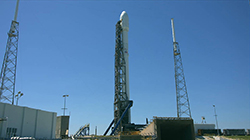 |
SpaceX Falcon 9 Rocket Ready to Launch NASA's TESS Spacecraft04.18.2018A SpaceX Falcon 9 rocket stands ready to launch NASA's Transiting Exoplanet Survey Satellite (TESS) from Space Launch Complex 40 at Cape Canaveral Air Force Station in Florida. View Image Feature |
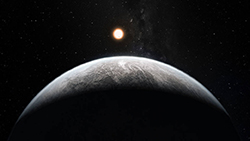 |
NASA's TESS Mission Hopes to Find Exoplanets Beyond Our Solar System04.13.2018The worlds orbiting other stars are called “exoplanets,” and they come in a wide variety of sizes, from gas giants larger than Jupiter to small, rocky planets about as big around as Earth or Mars. View Image Feature |
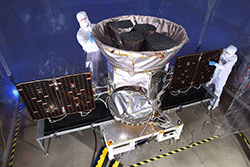 |
This is TESS, Our Newest Planet-Hunter03.28.2018TESS, the Transiting Exoplanet Survey Satellite, is the next step in the search for planets outside of our solar system, including those that could support life. View Image Feature |
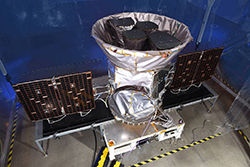 |
NASA's TESS - Transiting Exoplanet Survey Satellite03.27.2018The fully integrated Transiting Exoplanet Survey Satellite (TESS), which will find thousands of new planets orbiting other stars. View Image Feature |
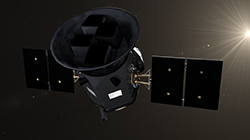 |
Illustration of TESS01.01.2018The Transiting Exoplanet Survey Satellite (TESS) will discover thousands of exoplanets in orbit around the brightest stars in the sky. In a two-year survey of the solar neighborhood, TESS will monitor more than 200,000 stars for temporary drops in brightness caused by planetary transits. View Image Feature |
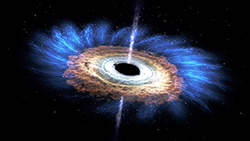 |
Star Wanders Too Close to a Black Hole11.24.2017This artist's rendering shows the tidal disruption event named ASASSN-14li, where a star wandering too close to a 3-million-solar-mass black hole was torn apart. View Image Feature |
ICON: Pegasus XL Processing10.13.2017The second and third stages of the Orbital ATK Pegasus XL rocket are offloaded from a transport vehicle at Building 1555 at Vandenberg Air Force Base in California in May 2017. View Image Feature |
|
 |
Chandra Samples Galactic Goulash06.26.2017What would happen if you took two galaxies and mixed them together over millions of years? A new image including data from NASA’s Chandra X-ray Observatory reveals the cosmic culinary outcome. View Image Feature |
 |
TESS Illustration04.12.2017Illustration of NASA's Transiting Exoplanet Survey Satellite — TESS. View Image Feature |
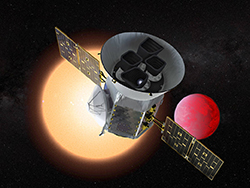 |
TESS Illustration04.12.2017Illustration of NASA's Transiting Exoplanet Survey Satellite — TESS — in front of a lava planet orbiting its host star. View Image Feature |
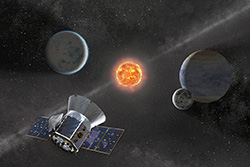 |
TESS Illustration04.12.2017Illustration of NASA's Transiting Exoplanet Survey Satellite — TESS — observing an M dwarf star with orbiting planets. View Image Feature |
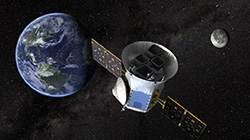 |
TESS Artist Concept04.09.2017NASA's Transiting Exoplanet Survey Satellite (TESS), shown here in a conceptual illustration, will identify exoplanets orbiting the brightest stars just outside our solar system. View Image Feature |
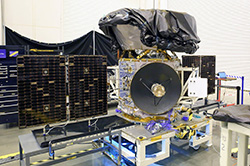 |
TESS With Solar Panels Integrated04.08.2017Photo of NASA's Transiting Exoplanet Survey Satellite — TESS — with solar arrays being deployed for testing at Orbital ATK in Dulles, Virginia. View Image Feature |
 |
TESS Cameras04.08.2017Cameras for NASA's Transiting Exoplanet Survey Satellite — TESS — being mounted onto the camera plate at Orbital ATK in Dulles, Virginia, prior to installation onto spacecraft. View Image Feature |
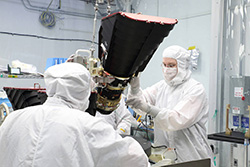 |
TESS Camera04.08.2017Cameras for NASA's Transiting Exoplanet Survey Satellite — TESS — being mounted onto the camera plate at Orbital ATK in Dulles, Virginia, prior to installation onto spacecraft. View Image Feature |
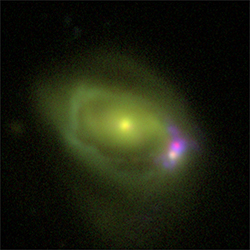 |
Was 49 Galaxy Merger03.27.2017This optical image shows the Was 49 system, which consists of a large disk galaxy, Was 49a, merging with a much smaller "dwarf" galaxy Was 49b. View Image Feature |
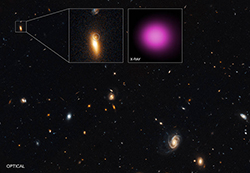 |
X-ray Telescopes Find Evidence for Wandering Black Hole10-05-2016Astronomers have used NASA's Chandra X-ray Observatory and ESA's XMM-Newton X-ray observatory to discover an extremely luminous, variable X-ray source located outside the center of its parent galaxy. View Image Feature |
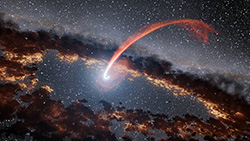 |
Infrared Echoes of a Black Hole Eating a Star09-15-2016This illustration shows a glowing stream of material from a star, disrupted as it was being devoured by a supermassive black hole. The feeding black hole is surrounded by a ring of dust. View Image Feature |
 |
Young Magnetar Likely the Slowest Pulsar Ever Detected09.08.2016Using NASA's Chandra X-ray Observatory and other X-ray observatories, astronomers have found evidence for what is likely one of the most extreme pulsars, or rotating neutron stars, ever detected. View Image Feature |
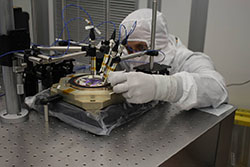 |
TESS Flight Lenses Before Modal Testing08.09.2016Optics engineer Greg Balonek prepares a TESS flight lens for modal testing at MIT Lincoln Laboratory View Image Feature |
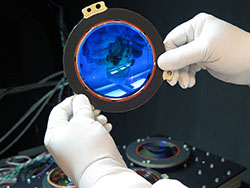 |
TESS Flight Lenses Before Thermal Chamber Testing08.09.2016Greg Allen, lead thermal engineer for the TESS instrument at MIT Lincoln Laboratory, works on TESS flight lenses. In this photo, the lenses are being prepared to go into the thermal chamber for hot-cold cycle testing. View Image Feature |
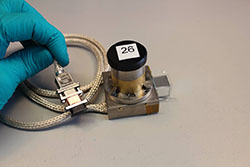 |
TESS Flight Star Trackers08.09.2016The TESS flight star tracker, provided by DTU Space for Orbital ATK, will monitor relative locations of stars and tell the spacecraft where it's pointing. Star trackers act as a sort of compass for the satellite. View Image Feature |
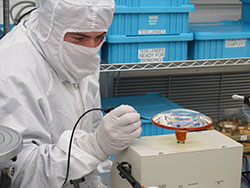 |
TESS Engineer Applies Room Temperature Vulcanization (RTV) Pads08.09.2016MIT Lincoln Laboratory Optical Engineer Christian Chesbrough applies room temperature vulcanization (RTV) pads to a TESS flight lens in the clean room at MIT Lincoln Laboratory in Lexington, Massachusetts. View Image Feature |
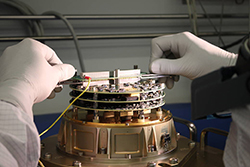 |
TESS Camera Electronics08.09.2016A set of flight camera electronics on one of the TESS cameras, developed by the MIT Kavli Institute for Astrophysics and Space Research (MKI), will transmit exoplanet data from the camera to a computer aboard the spacecraft that will process it before transmitting it back to scientists on Earth. View Image Feaute |
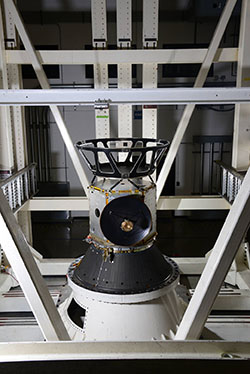 |
TESS Spacecraft08.09.2016Pictured is the TESS spacecraft and its high gain antenna before being shipped to Orbital ATK. The spacecraft sits atop the SpaceX launch vehicle adapter ring for the Falcon 9 rocket that will launch TESS. View Image Feature |
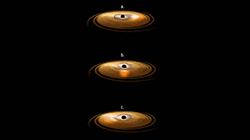 |
Black Hole with ‘Wobbling’ Disk07.12.2016This artist's impression depicts the accretion disc surrounding a black hole, in which the inner region of the disc precesses. “Precession” means that the orbit of material surrounding the black hole changes orientation around the central object. View Image Feature |
ICON and Airglow - Daytime View04.06.2016Charged particles in Earth's atmosphere – which make up the ionosphere – create bands of color above Earth's surface, known as airglow. View Image Feature |
|
Airglow and Earth's Magnetic Field04.04.2016Around Earth's equator, bright swaths of color known as airglow, can appear hovering at about 50 to 300 miles above the surface of Earth. View Image Feature |
|
Earth's Pulsating Ionosphere04.04.2016A layer of charged particles, called the ionosphere, surrounds Earth, extending from about 50 to 360 miles above the surface of the planet – shown in purple and not-to-scale in this image. View Image Feature |
|
ICON's FUV Instrument04.01.2016The Far Ultra Violet Imaging Spectrograph, or FUV, for the NASA ICON mission during a test of the door release mechanism at Lockheed Martin in August 2015. View Image Feature |
|
Mighty Engineers, MIGHTI Instrument04.01.2016A team of engineers at the Naval Research Laboratory in Washington, D.C., stands behind the instrument they built — the Michelson Interferometer for Global High-resolution Thermospheric Imaging, or MIGHTI, instrument – for NASA's ICON mission. View Image Feature |
|
ICON's FUV, Aperture Closed04.01.2016The front of the Far Ultra Violet Imaging Spectrograph, or FUV, for the NASA ICON mission. This image shows the door that covers the turret. View Image Feature |
|
Upper Atmospheric Airglow04.01.2016Bright swaths of red in the upper atmosphere, known as airglow, can be seen in this image taken from the International Space Station. View Image Feature |
|
Infographic: ICON and the Edge of the Atmosphere04.01.2016NASA's ICON mission will orbit above the upper atmosphere, through the bottom edge of near-Earth space. View Image Feature |
|
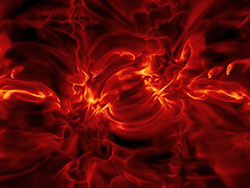 |
Pleiades Supercomputer Simulations Help Explain NASA's IRIS Solar Observatory Findings01.28.2016Researchers around the world are studying the sun to better understand its formation, evolution, and impact on Earth. To help explain longstanding mysteries of the sun's atmosphere, scientists turned to one of the world's fastest supercomputers, Pleiades, located at the NASA Advanced Supercomputing (NAS) facility, at Ames Research Center in California's Silicon Valley. View Image Feature |
 |
Bow Shocks in Space01.05.2016Bow shocks thought to mark the paths of massive, speeding stars are highlighted in these images from NASA's Spitzer Space Telescope and Wide-field Infrared Survey Explorer, or WISE. View Image Feature |
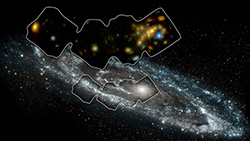 |
Andromeda in High-Energy X-rays01.05.2016NASA's Nuclear Spectroscope Telescope Array, or NuSTAR, has imaged a swath of the Andromeda galaxy — the nearest large galaxy to our own Milky Way galaxy. View Image Feature |
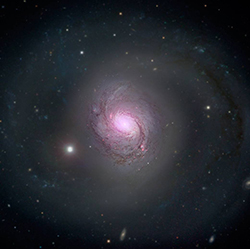 |
NuSTAR's View of Galaxy 106812.17.2015Galaxy 1068 is shown in visible light and X-rays in this composite image. High-energy X-rays (magenta) captured by NASA's Nuclear Spectroscopic Telescope Array, or NuSTAR, are overlaid on visible-light images from both NASA's Hubble Space Telescope and the Sloan Digital Sky Survey. View Image Feature |
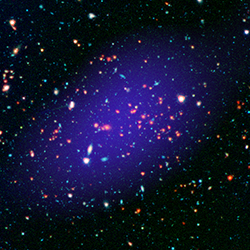 |
A Giant Gathering of Galaxies11.03.2015The galaxy cluster called MOO J1142+1527 can be seen here as it existed when light left it 8.5 billion years ago. The red galaxies at the center of the image make up the heart of the galaxy cluster. View Image Feature |
 |
The Anatomy of a Black Hole Flare10.27.2015This diagram shows how a shifting feature, called a corona, can create a flare of X-rays around a black hole. The corona (feature represented in purplish colors) gathers inward (left), becoming brighter, before shooting away from the black hole (middle and right). View Image Feature |
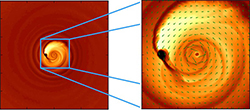 |
Intricate Dance of Black Holes09.16.2015This simulation helps explain an odd light signal thought to be coming from a close-knit pair of merging black holes, PG 1302-102, located 3.5 billion light-years away. VIew Image Feature |
 |
NuSTAR Stares at the Sun07.08.2015Flaring, active regions of our sun are highlighted in this new image combining observations from several telescopes. High-energy X-rays from NASA's Nuclear Spectroscopic Telescope Array (NuSTAR) are shown in blue; low-energy X-rays from Japan's Hinode spacecraft are green; and extreme ultraviolet light from NASA's Solar Dynamics Observatory (SDO) is yellow and red. View Image Feature |
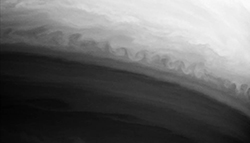 |
Surfer Waves on Saturn07.08.2015The pattern of an iconic surfer's wave, seen here in the atmosphere of Saturn as captured by NASA's Cassini mission, has been observed in many places all over the universe, including at the edges of Earth's magnetic environment. View Image Feature |
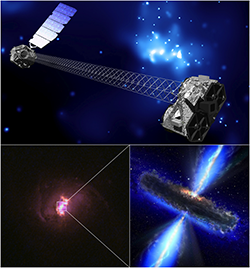 |
NuSTAR Seeks Hidden Black Holes07.06.2015An illustration of NASA's Nuclear Spectroscopic Telescope Array, or NuSTAR, in orbit. The unique school bus-long mast allows NuSTAR to focus high energy X-rays. View Image Feature |
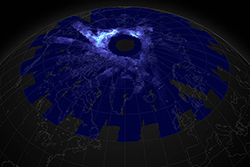 |
Night-Shining Clouds06.19.2015In the late spring and summer, unusual clouds form high in the atmosphere above the polar regions of the world. As the lower atmosphere warms, the upper atmosphere gets cooler, and ice crystals form on meteor dust and other particles high in the sky. View Image Feature |
 |
First Night-Shining Clouds of 2015 Arctic Season06.02.2015NASA’s Aeronomy of Ice in the Mesosphere, or AIM, spacecraft has spotted a luminous patch of electric-blue drifting across the Arctic Circle. The sighting marks the beginning of the 2015 season for noctilucent clouds (NLCs). View Image Feature |
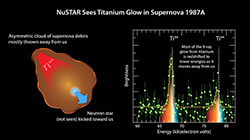 |
Tracing Titanium's Escape05.07.2015The plot of data from NASA's Nuclear Spectroscopic Telescope Array, or NuSTAR (right), amounts to a “smoking gun” of evidence in the mystery of how massive stars explode. View Image Feature |
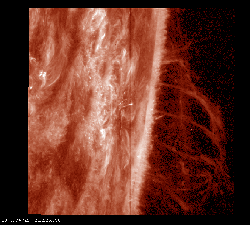 |
IRIS Celebrates 10,000th Orbit05.06.2015In this photo, NASA's Interface Region Imaging Spectrograph (IRIS) spacecraft captured several large solar prominences on the edge of the sun last week. On May 6, 2015, IRIS completed its 10,000th orbit of the Earth. View Image Feature |
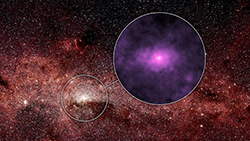 |
Extra X-rays at the Hub of Our Milky Way Galaxy04.29.2015NASA's Nuclear Spectroscopic Telescope Array, or NuSTAR, has captured a new high-energy X-ray view (magenta) of the bustling center of our Milky Way galaxy. View Image Feature |
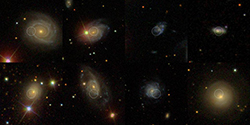 |
After the Explosion: Investigating Supernova Sites03.26.2015A new study analyzes several sites where dead stars once exploded. View Image Feature |
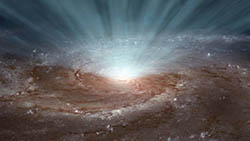 |
How Black Hole Winds Blow02.19.2015Supermassive black holes at the cores of galaxies blast radiation and ultra-fast winds outward, as illustrated in this artist's conception. View Image Feature |
 |
Tale of Two Black Holes01.08.2015The real monster black hole is revealed in this new image from NASA's Nuclear Spectroscopic Telescope Array of colliding galaxies Arp 299. View Image Feature |
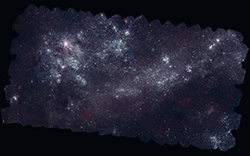 |
Swift Gamma-Ray Burst Mission Marks Ten Years of Discovery11.20.2014On Nov. 20, 2004, NASA's Swift spacecraft lifted off aboard a Boeing Delta II rocket from Cape Canaveral Air Force Station, Fla., beginning its mission to study gamma-ray bursts and identify their origins. View Image Feature |
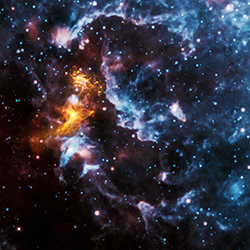 |
Illusions in the Cosmic Clouds10.23.2014Pareidolia is the psychological phenomenon where people see recognizable shapes in clouds, rock formations, or otherwise unrelated objects or data. There are many examples of this phenomenon on Earth and in space. View Image Feature |
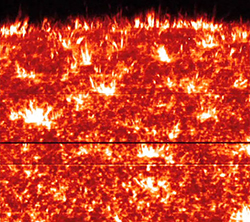 |
IRIS Helps to Explain Solar Atmospheric Heating10.16.2014This screen capture from a video shows NASA's Interface Region Imaging Spectrograph's, or IRIS', view of an area of the sun. Multiple images of this area were taken in different wavelengths. View Image Feature |
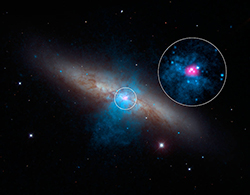 |
NuSTAR Finds a Pulse in Cigar Galaxy10.07.2014High-energy X-rays streaming from a rare and mighty pulsar (magenta), the brightest found to date, can be seen in this new image combining multi-wavelength data from three telescopes. View Image Feature |
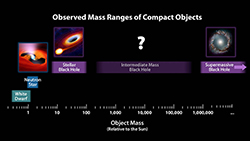 |
Mass Chart for Dead Stars and Black Holes10.07.2014This chart illustrates the relative masses of super-dense cosmic objects, ranging from white dwarfs to the supermassive black holes encased in the cores of most galaxies. View Image Feature |
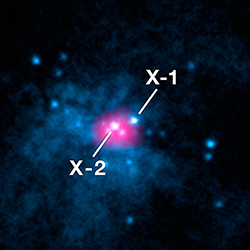 |
Ultraluminous X-ray Sources in M82 Galaxy10.07.2014This image shows the core of galaxy Messier 82 (M82), where two ultraluminous X-ray sources, or ULXs, reside (X-1 and X-2). ULXs are regions that shine intensely with X-rays. View Image Feature |
 |
NuSTAR Captures the Beat of a Dead Star10.07.2014The brightest pulsar detected to date is shown in this animation that flips back and forth between images captured by NASA's Nuclear Spectroscopic Telescope Array, or NuSTAR. View Image Feature |
 |
Two Views of an X-Class Flare on Sept. 10, 201409.17.2014Two views of an X-class solar flare on Sept. 10, 2014. NASA's newest solar observatory, the Interface Region Imaging Spectrograph, or IRIS, mission joined other telescopes, including NASA's Solar Dynamics Observatory, or SDO, to witness an X-class flare on the sun. View Image Feature |
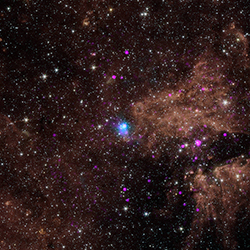 |
Powerful, Pulsating Core of Star09.16.2014The blue dot in this image marks the spot of an energetic pulsar — the magnetic, spinning core of star that blew up in a supernova explosion. View Image Feature |
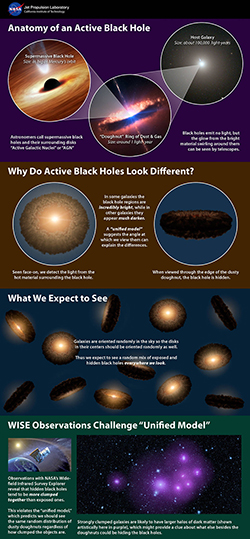 |
Unified, or ‘Doughnut,’ Theory of Active, Black Holes05.22.2014This infographic explains a popular theory of active supermassive black holes, referred to as the unified model — and how new data from NASA's Wide-field Infrared Survey Explorer, or WISE, is at conflict with the model. View Image Feature |
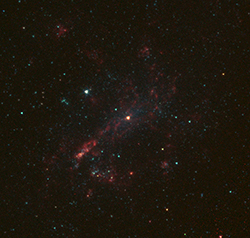 |
Bulgeless Galaxy Hides Black Hole03.26.2014The galaxy NGC 4395 is shown here in infrared light, captured by NASA's Spitzer Space Telescope. This dwarf galaxy is relatively small in comparison with our Milky Way galaxy, which is nearly 1,000 times more massive. View Image Feature |
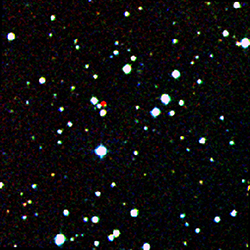 |
A New Solar Neighbor03.07.2014A nearby star stands out in red in this image from the Second Generation Digitized Sky Survey. The star, called WISEA J204027.30+695924.1, was initially discovered using data from NASA's Wide-field Infrared Survey Explorer (WISE), which scanned the entire sky in infrared light in 2010 and early 2011, before ending its primary mission in Feb. 2011. View Image Feature |
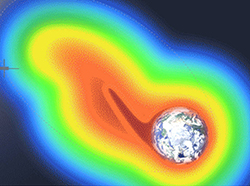 |
Plasmasphere Plume Protection03.06.2014NASA's THEMIS mission observed how dense particles normally near Earth in a layer of the uppermost atmosphere called the plasmasphere (colored orange) can send a plume up through space to help protect against incoming solar particles during certain space weather events. View Image Feature |
 |
Magnetosphere - Plasmasphere03.06.2014This illustration of Earth's magnetosphere shows a thin layer of cold, dense material called the plasmasphere surrounds Earth, located inside the radiation belts. Researchers have found that material in the plasmasphere can help prevent particles from the sun crossing into near Earth space. View Image Feature |
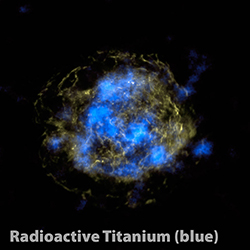 |
Radioactive Core of a Dead Star02.19.2014NASA's Nuclear Spectroscope Telescope Array, or NuSTAR, has, for the first time, imaged the radioactive “guts” of a supernova remnant, the leftover remains of a star that exploded. View Image Feature |
 |
The Case of Missing Iron in Cassiopeia A02.19.2014When astronomers first looked at images of a supernova remnant called Cassiopeia A, captured by NASA's Nuclear Spectroscopic Telescope Array, or NuSTAR, they were shocked. View Image Feature |
 |
Adding a New “Color” to Palate of Cassiopeia A Images02.18.2014Elements making up the shredded remains of a massive star that exploded in a supernova are highlighted in this three-panel view. View Image Feature |
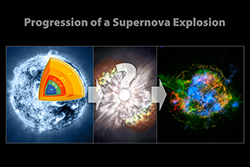 |
Evolution of a Supernova02.18.2014These illustrations show the progression of a supernova blast. A massive star (left), which has created elements as heavy as iron in its interior, blows up in a tremendous explosion (middle), scattering its outer layers in a structure called a supernova remnant (right). View Image Feature |
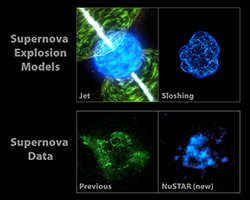 |
NuSTAR Data Point to Sloshing Supernovas02.18.2014How massive stars blow up in powerful explosions called supernovas remains a mystery. Theorists have come up with computer simulations to try to recreate what happens, but it's not clear which model is correct. View Image Feature |
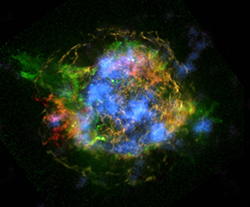 |
Untangling the Remains of Cassiopeia A02.18.2014The mystery of how Cassiopeia A exploded is unraveling thanks to new data from NASA's Nuclear Spectroscopic Telescope Array, or NuSTAR. View Image Feature |
Asteroid Tracks Among the Stars01.23.2014More than 100 asteroids were captured in this view from NASA's Wide-field Infrared Survey Explorer, or WISE, during its primary all-sky survey. In August of this year, the mission was revived to hunt more asteroids, and renamed NEOWISE. View Image Feature |
|
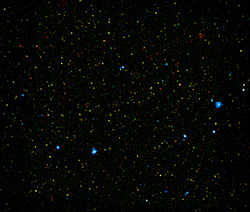 |
Different Flavors of Black Holes01.09.2014A range of supermassive black holes lights up this new image from NASA's Nuclear Spectroscopic Telescope Array, or NuSTAR. View Image Feature |
 |
High-Energy X-ray View of ‘Hand of God’01.09.2014Can you see the shape of a hand in this new X-ray image? The hand might look like an X-ray from the doctor's office, but it is actually a cloud of material ejected from a star that exploded. View Image Feature |
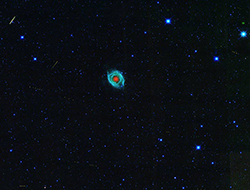 |
March of Asteroids Across Dying Star12.12.2013A dying star, called the Helix nebula, is shown surrounded by the tracks of asteroids in an image captured by NASA's Wide-field Infrared Survey Explorer, or WISE. The nebula is far outside our solar system, while the asteroid tracks are inside our solar system. View Image Feature |
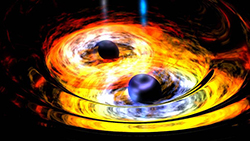 |
Two Black Holes on Way to Becoming One12.03.13Two black holes are entwined in a gravitational tango in this artist's conception. Supermassive black holes at the hearts of galaxies are thought to form through the merging of smaller, yet still massive black holes, such as the ones depicted here. View Image Feature |
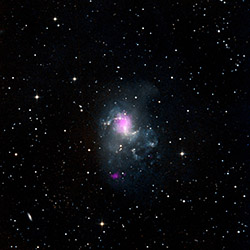 |
Topsy Turvy Black Holes11.26.2013The magenta spots in this image show two black holes in the spiral galaxy called NGC 1313, or the Topsy Turvy galaxy. Both black holes belong to a class called ultraluminous X-ray sources, or ULXs. View Image Feature |
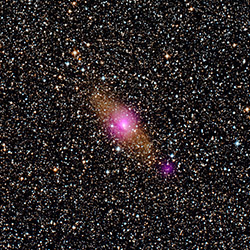 |
Black Holes of the Circinus Galaxy11.26.2013The magenta spots in this image show two black holes in the Circinus galaxy: the supermassive black hole at its heart, and a smaller one closer to the edge that belongs to a class called ultraluminous X-ray sources, or ULXs. View Image Feature |
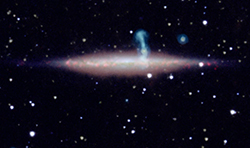 |
Two Galaxies Masquerading as One11.14.2013The edge-on spiral galaxy UGC 10288 appeared to be a single object in previous observations. However, new detailed radio data from the NRAO's Jansky Very Large Array (VLA) revealed that the large perpendicular extension of UGC 10288's halo (blue) is really a distant background galaxy with radio jets. View Image Feature |
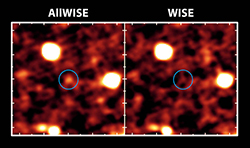 |
AllWISE Brings Galaxies Out of Hiding11.14.2013The new AllWISE catalog will bring distant galaxies that were once invisible out of hiding, as illustrated in this image. NASA's AllWISE project is providing the astronomy community with new and improved images and data taken by NASA's Wide-field Infrared Survey Explorer, or WISE, which surveyed the skies in infrared light in 2010. View Image Feature |
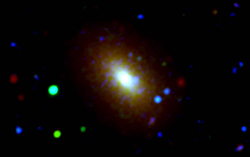 |
Galaxies Grow from Inside Out10.31.2013New evidence from NASA's Wide-field Infrared Survey Explorer (WISE) and Galaxy Evolution Explorer (GALEX) missions provide support for the "inside-out" theory of galaxy evolution, which holds that star formation starts at the core of the galaxy and spreads outward. View Image Feature |
 |
Galaxies Grow from Inside Out10.31.2013New evidence from NASA's Wide-field Infrared Survey Explorer (WISE) and Galaxy Evolution Explorer (GALEX) missions provide support for the “inside-out” theory of galaxy evolution, which holds that star formation starts at the core of the galaxy and spreads outward. View Image Feature |
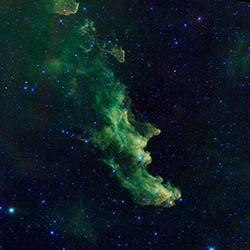 |
‘Witch Head’ Brews Baby Stars10.30.2013A witch appears to be screaming out into space in this new image from NASA's Wide-Field Infrared Survey Explorer, or WISE. The infrared portrait shows the Witch Head nebula, named after its resemblance to the profile of a wicked witch. View Image Feature |
 |
Eight Spacecraft Track Energy through Space09.26.2013On July 3, 2012, eight spacecraft were lined up on the night side of Earth, enabling scientists to track how magnetic energy from the sun moved around Earth, reconnected at a point about half way to the moon, and then spread through the back end of Earth’s magnetic environment, the magnetotail. View Image Feature |
 |
Brown Dwarf Backyardigans09.05.2013The locations of brown dwarfs discovered by NASA's Wide-field Infrared Survey Explorer, or WISE, and mapped by NASA's Spitzer Space Telescope, are shown in this diagram. The view is from a vantage point about 100 light-years away from the sun, looking back toward the constellation Orion. View Image Feature |
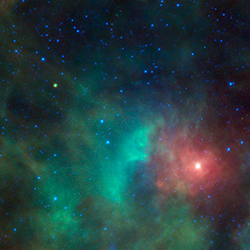 |
Asteroid Zips By Orion Nebula08.23.2013This image shows the potentially hazardous near-Earth object 1998 KN3 as it zips past a cloud of dense gas and dust near the Orion nebula. NEOWISE, the asteroid-hunting portion of the Wide-field Infrared Survey Explorer, or WISE, mission, snapped infrared pictures of the asteroid, seen as the yellow-green dot at upper left. View Image Feature |
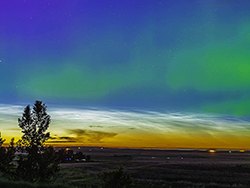 |
Sky Colors Trifecta08.19.2013On June 9, 2013 Alan Dyer of Gleichen, Alberta, Canada went outside to see the colors of the sunset. He got more than he bargained for. View Image Feature |
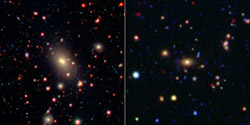 |
Monster in the Middle: Brightest Cluster Galaxy08.01.2013This image shows two of the galaxy clusters observed by NASA's Wide-field Infrared Survey Explorer (WISE) and Spitzer Space Telescope missions. View Image Feature |
 |
Comparison of Resolution Between SDO and IRIS07.25.2013This image compares the Solar Dynamics Observatory (SDO) Atmospheric Imaging Assembly (AIA) at 1600 Angstroms (on left) to the IRIS' Si IV (on right). View Image Feature |
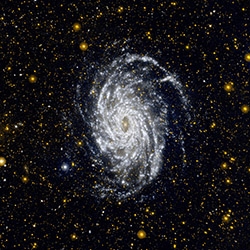 |
Big Brother to the Milky Way07.01.2013This image from NASA's Galaxy Evolution Explorer shows NGC 6744, one of the galaxies most similar to our Milky Way in the local universe. View Image Feature |
 |
Ultraviolet Ring of Stars07.01.2013This image from NASA's Galaxy Evolution Explorer (GALEX) shows Messier 94, also known as NGC 4736, in ultraviolet light. View Image Feature |
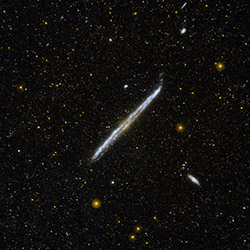 |
Galaxy's Pencil-Thin Profile07.01.2013This image from NASA's Galaxy Evolution Explorer shows NGC 4565, one of the nearest and brightest galaxies not included in the famous list by 18th-century comet hunter Charles Messier. View Image Feature |
 |
Aircraft Carrying IRIS Solar Observatory Takes Off06.28.2013An Orbital Sciences L-1011 carrier aircraft takes off from Vandenberg Air Force Base, Calif., on a mission to launch NASA's IRIS spacecraft into low-Earth orbit. View Image Feature |
 |
Stargazer Aircraft Carrying IRIS Takes Off06.27.2013The Orbital Sciences L-1011 aircraft takes off from Vandenberg Air Force Base in California at 9:30 p.m. EDT on June 27, 2013, headed over the Pacific Ocean to release the Pegasus XL rocket carrying NASA's Interface Region Imaging Spectrograph, or IRIS, solar observatory. View Image Feature |
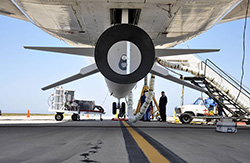 |
IRIS Launch Set for Thursday06.26.2013Technicians and engineers at Vandenberg Air Force Base in California mate the Pegasus XL rocket with the Interface Region Imaging Spectrograph, or IRIS, solar observatory to the Orbital Sciences L-1011 carrier aircraft. View Image Feature |
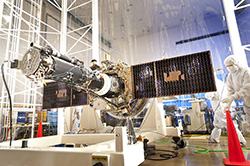 |
IRIS Preps for Launch06.20.2013The fully integrated spacecraft and science instrument for NASA's Interface Region Imaging Spectrograph (IRIS) mission is seen in a clean room at the Lockheed Martin Space Systems Sunnyvale, Calif. facility. View Image Feature |
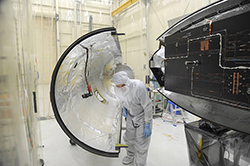 |
Preparing NASA's Next Solar Satellite for Launch06.12.2013Orbital Sciences team members move the second half of the payload fairing before it is placed over NASA's IRIS (Interface Region Imaging Spectrograph) spacecraft. The fairing connects to the nose of the Orbital Sciences Pegasus XL rocket that will lift the solar observatory into orbit. View Image Feature |
 |
Sculptor Galaxy Shines with X-rays06.11.2013The Sculptor galaxy is seen in a new light, in this composite image from NASA's Nuclear Spectroscopic Telescope Array (NuSTAR) and the European Southern Observatory in Chile. View Image Feature |
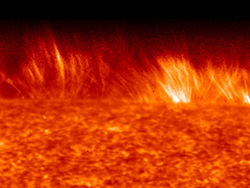 |
Hinode's View of Interface Region05.29.2013This image from JAXA's Hinode mission shows the lower regions of the sun's atmosphere, the interface region, which a new mission called the Interface Region Imaging Spectrograph, or IRIS, will study in exquisite detail. View Image Feature |
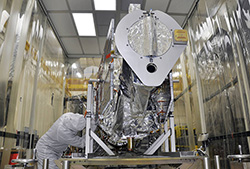 |
IRIS Spacecraft04.25.2013A technician finishes removing protective Mylar wrapping from NASA's IRIS spacecraft in a clean room at Vandenberg Air Force Base in California, where the spacecraft will be readied for launch aboard an Orbital Sciences Pegasus XL rocket. View Image Feature |
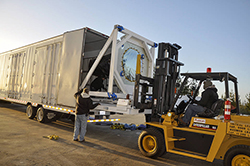 |
IRIS Spacecraft Arrives04.18.2013Workers unload NASA's IRIS spacecraft from a truck at the processing facility at Vandenberg where the spacecraft will be readied for launch aboard an Orbital Sciences Pegasus XL rocket. View Image Feature |
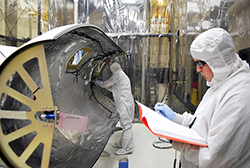 |
Preparing Solar Satellite for Launch04.18.2013VANDENBERG AFB, Calif. – Technicians work on the payload fairing that will protect NASA's Interface Region Imaging Spectrograph (IRIS) spacecraft during launch aboard an Orbital Sciences Pegasus XL rocket. Launch is currently scheduled no earlier than May 28, 2013. View Image Feature |
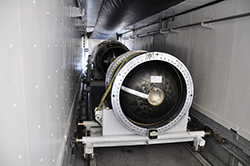 |
Pegasus Third Stage03.27.2013A truck carrying the third stage of the Orbital Sciences Pegasus XL rocket that will carry NASA's Interface Region Imaging Spectrograph (IRIS) spacecraft arrives at Vandenberg Air Force Base in California. View Image Feature |
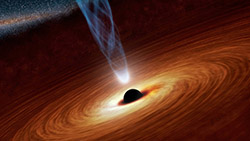 |
Black Holes: Monsters in Space02.27.2013This artist's concept illustrates a supermassive black hole with millions to billions times the mass of our sun. Supermassive black holes are enormously dense objects buried at the hearts of galaxies. View Image Feature |
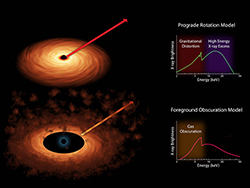 |
Two Models of Black Hole Spin02.27.2013Scientists measure the spin rates of supermassive black holes by spreading the X-ray light into different colors. The light comes from accretion disks that swirl around black holes, as shown in both of the artist's concepts. View Image Feature |
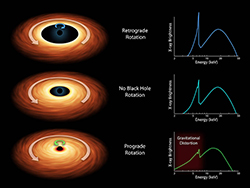 |
How to Measure the Spin of a Black Hole02.27.2013Black holes are tremendous objects whose immense gravity can distort and twist space-time, the fabric that shapes our universe. These effects, consequences of Einstein's general theory of relativity, result in the bending of light as it travels through space-time. View Image Feature |
 |
THEMIS in the Magnetosphere02.25.2013Earth is surrounded by a giant magnetic bubble, called the magnetosphere. Over six years in space, five spacecraft from the THEMIS mission have helped map out this area and improve our ability to predict dynamic space weather events – events that at their worst can impact satellites in space. View Image Feature |
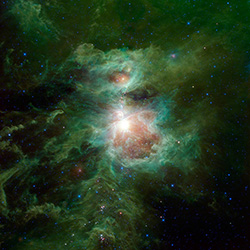 |
The Cosmic Hearth02.06.2013The Orion nebula is featured in this sweeping image from NASA's Wide-field Infrared Survey Explorer, or WISE. The constellation of Orion is prominent in the evening sky throughout the world from about December through April of each year. View Image Feature |
Terrestrial Atmosphere ITM Processes01.23.2013This model is an indication of the complexity of the ionosphere-thermosphere-mesosphere (ITM) system of planet Earth and the range of physical processes operating. View Image Feature |
|
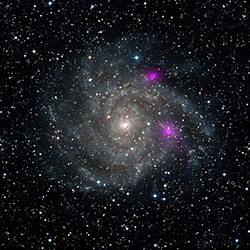 |
Blazing Black Holes Spotted in Spiral Beauty01.11.2013This new view of spiral galaxy IC 342, also known as Caldwell 5, includes data from NASA's Nuclear Spectroscopic Telescope Array, or NuSTAR. View Image Feature |
 |
Sizzling Remains of a Dead Star01.09.2013This new view of the historical supernova remnant Cassiopeia A, located 11,000 light-years away, was taken by NASA's Nuclear Spectroscopic Telescope Array, or NuSTAR. Blue indicates the highest energy X-ray light, where NuSTAR has made the first resolved image ever of this source. View Image Feature |
 |
First Look at Milky Way's Monster in High-Energy X-ray Light10.23.2012These are the first, focused high-energy X-ray views of the area surrounding the supermassive black hole, called Sagittarius A*, at the center of our galaxy. View Image Feature |
 |
Pointing X-ray Eyes at our Resident Supermassive Black Hole10.23.2012NASA's Nuclear Spectroscopic Telescope Array, or NuSTAR, has captured these first, focused views of the supermassive black hole at the heart of our galaxy in high-energy X-ray light. View Image Feature |
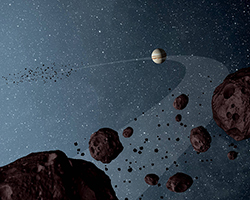 |
Trojan Colors Revealed (Artist's Concept)10.15.2012New results from NASA's Wide-field Infrared Explorer, or WISE, reveal that the Jovian Trojans - asteroids that lap the sun in the same orbit as Jupiter - are uniformly dark with a hint of burgundy color, and have matte surfaces that reflect little sunlight. View Image Feature |
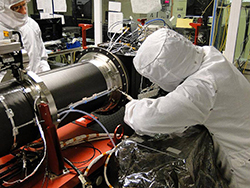 |
Working On IRIS Spectrometer10.11.2012An engineer works on the spectrometer instrument for the Interface Region Imaging Spectrograph (IRIS). IRIS is a NASA Small Explorer Mission to observe how solar material moves, gathers energy, and heats up as it travels through a little-understood region in the sun's lower atmosphere. View Image Feature |
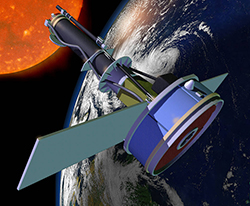 |
Concept IRIS in Orbit10.10.2012Artist's concept of the Interface Region Imaging Spectrograph (IRIS) satellite in orbit. View Image Feature |
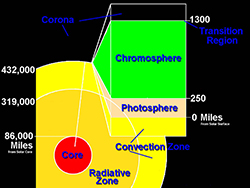 |
Layers of the Sun10.10.2012This graphic shows a model of the layers of the Sun, with approximate mileage ranges for each layer: for the inner layers, the mileage is from the sun's core; for the outer layers, the mileage is from the sun's surface. View Image Feature |
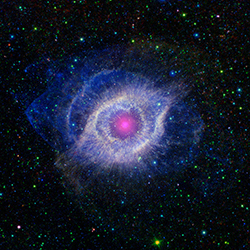 |
Helix Nebula - Unraveling at the Seams10.04.2012A dying star is throwing a cosmic tantrum in this combined image from NASA's Spitzer Space Telescope and the Galaxy Evolution Explorer (GALEX), which NASA has lent to the California Institute of Technology in Pasadena. View Image Feature |
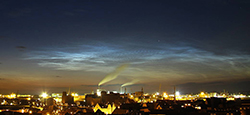 |
Shuttle Exhaust Tied to PMCs Over Scandinavia08.30.2012Noctilucent clouds – also known as polar mesospheric clouds (PMCs) over Wismar, Germany on July 9, 2011. These clouds shine brightly even during the night. View Image Feature |
 |
Extremely Bright and Extremely Rare08.29.2012This image zooms in on the region around the first "hot DOG" (red object in magenta circle), discovered by NASA's Wide-field Infrared Survey Explorer, or WISE. Hot DOGs are hot dust-obscured galaxies. View Image Feature |
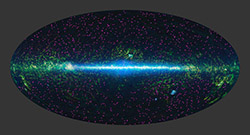 |
Galaxies Burn Bright Like High-Wattage ‘Light Bulbs’08.29.2012NASA's Wide-field Infrared Survey Explorer (WISE) has identified about 1,000 extremely obscured objects over the sky, as marked by the magenta symbols. View Image Feature |
 |
Homing in on ‘Hot Dogs’08.29.2012This image is a portion of the all-sky survey from NASA's Wide-field Infrared Survey Explorer, or WISE. It highlights the first of about 1,000 "hot DOGs" found by the mission (magenta circle). View Image Feature |
 |
Noctilucent Clouds as Seen from ISS08.08.2012Astronauts on board the International Space Station (ISS) took this picture of noctilucent clouds (NLCs) near the top of Earth's atmosphere on July 13, 2012. View Image Feature |
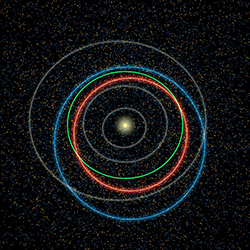 |
The Hustle and Bustle of Our Solar System07.30.2012This diagram illustrates the differences between orbits of a typical near-Earth asteroid (blue) and a potentially hazardous asteroid, or PHA (orange). PHAs are a subset of the near-Earth asteroids (NEAs) and have the closest orbits to Earth's orbit, coming within 5 million miles (about 8 million kilometers). View Image Feature |
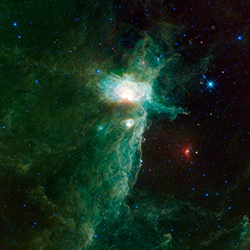 |
The Flame Nebula07.26.2012The Flame Nebula sits on the eastern hip of Orion the Hunter, a constellation most easily visible in the northern hemisphere during winter evenings. This view of the nebula was taken by WISE, NASA's Wide-field Infrared Survey Explorer. View Image Feature |
 |
Black Hole Caught in a Stellar Homicide07.11.2012This computer-simulated image shows gas from a star that is ripped apart by tidal forces as it falls into a black hole. View Image Feature |
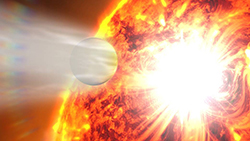 |
A Change in the Air07.10.2012An international team of astronomers using data from NASA's Hubble Space Telescope made an unparalleled observation, detecting significant changes in the atmosphere of a planet located beyond our solar system. View Image Feature |
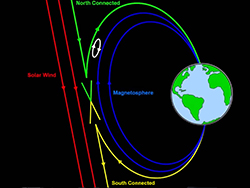 |
X Marks the Spot for Magnetic Reconnection07.02.2012X marks the spot of magnetic reconnection, creating portals or openings where the solar wind can enter Earth's magnetic field. Mingling lines of magnetic force from the sun and Earth criss-cross and join to create the openings. View Image Feature |
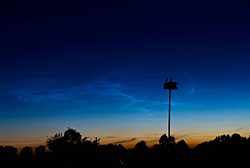 |
Storks and NLCs Return in 201206.17.2012These Noctilucent Clouds (NLCs) were photographed on June 17, 2012 in Szubin, Poland. On top of the pole in the foreground are nesting storks. View Image Feature |
 |
NuSTAR Spacecraft Joined to Rocket06.11.2012In this image from February 2012, technicians review their checklists after joining NASA's NuSTAR spacecraft with the Orbital Sciences Pegasus XL rocket inside an environmental enclosure at Vandenberg Air Force Base's processing facility in California. View Image Feature |
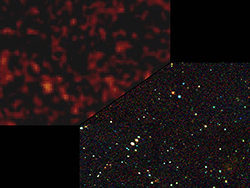 |
Bringing Black Holes Into Focus05.30.2012This image comparison demonstrates NuSTAR's improved ability to focus high-energy X-ray light into sharp images. The image on the left, taken by the European Space Agency's INTEGRAL satellite, shows high-energy X-rays from galaxies beyond our own. View Image Feature |
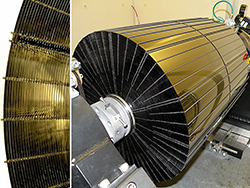 |
NuSTAR's Russian Doll-like Mirrors05.30.2012NASA's Nuclear Spectroscopic Telescope Array, or NuSTAR, has a complex set of mirrors, or optics, that will help it see high-energy X-ray light in greater detail than ever before. View Image Feature |
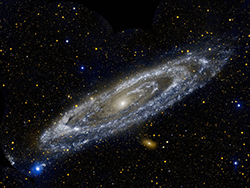 |
The Galaxy Next Door05.15.2012Hot stars burn brightly in this new image from NASA's Galaxy Evolution Explorer, showing the ultraviolet side of a familiar face. View Image Feature |
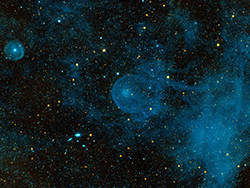 |
Plowing Through the Depths of Space05.14.2012A runaway star, plowing through the depths of space and piling up interstellar material before it, can be seen in this ultraviolet image from NASA's Galaxy Evolution Explorer. View Image Feature |
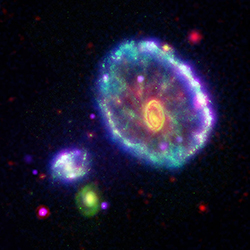 |
Cosmic Cartwheel of Color05.14.2012This image of the Cartwheel galaxy shows a rainbow of multi-wavelength observations from NASA missions, including the Galaxy Evolution Explorer (blue), the Hubble Space Telescope (green), the Spitzer Space Telescope (red) and the Chandra X-ray Observatory (purple). View Image Feature |
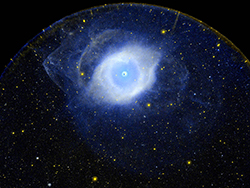 |
Helix Nebula05.14.2012This is the Helix nebula, as seen in ultraviolet light. It is a star like our sun but at the very end of its life. The star is a small dot in the center, surrounded by billowy layers of expelled material. View Image Feature |
 |
A Star with a Comet-Like Tail05.14.2012A speeding star can be seen leaving an enormous trail in this image from NASA's Galaxy Evolution Explorer. View Image Feature |
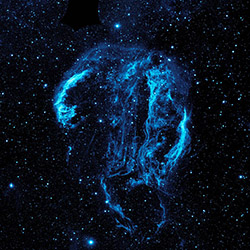 |
Filigree and Shadow03.26.2012Wispy tendrils of hot dust and gas glow brightly in this ultraviolet image of the Cygnus Loop Nebula, taken by NASA's Galaxy Evolution Explorer. View Image Feature |
 |
Cygnus Loop Nebula03.22.2012Wispy tendrils of hot dust and gas glow brightly in this ultraviolet image of the Cygnus Loop nebula, taken by NASA's Galaxy Evolution Explorer. View Image Feature |
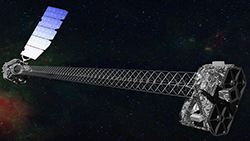 |
Artist's Concept of NuSTAR03.06.2012Artist's concept of NuSTAR on orbit. NuSTAR has a 10-m (30') mast that deploys after launch to separate the optics modules (right) from the detectors in the focal plane (left). View Image Feature |
 |
THEMIS in Orbit02.17.2012An artist's conception of one of the THEMIS spacecraft in orbit around Earth. View Image Feature |
 |
THEMIS Ground Stations02.17.2012In additional to the five THEMIS spacecraft launched into space, 20 THEMIS ground stations can observe aurora from the ground. View Image Feature |
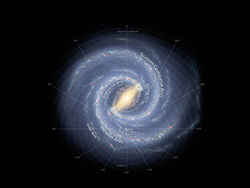 |
Milky Way and Our Location02.01.2012Graphic view of our Milky Way Galaxy. The Milky Way Galaxy is organized into spiral arms of giant stars that illuminate interstellar gas and dust. View Image Feature |
 |
Our Cosmic Neighborhood02.01.2012Due to the protective shielding of dangerous Galactic Cosmic Rays provided by a heliosphere or astrosphere, these structures are important for the planets that orbit the respective stars. Only over the last 15 years, we have been able to detect the first astrospheres and planets around other stars (exoplanets). View Image Feature |
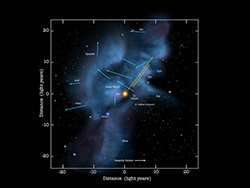 |
Our Solar Journey Through the Milky Way02.01.2012Our solar journey through space is carrying us through a cluster of very low density interstellar clouds. Right now the Sun is inside of a cloud (Local cloud) that is so tenuous that the interstellar gas detected by IBEX is as sparse as a handful of air stretched over a column that is hundreds of light years long. View Image Feature |
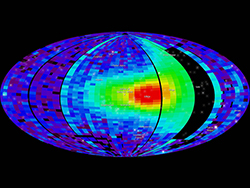 |
IBEX Full Sky Map 01.31.201201.31.2012Color-coded full sky neutral atom map, as obtained with IBEX at energies where the interstellar wind is the brightest feature in the maps. In Earth's orbit, where IBEX makes its observations, the maximum flow (in red) is seen to arrive from Libra instead of Scorpio because the interstellar wind is forced to curve around the Sun by gravity. View Image Feature |
 |
Earth's Radiation Belts Tremble Under Impact of 2003 Halloween Storm01.30.2012Under the wave of energetic particles from the Halloween 2003 solar storm events, the Earth's radiation belts underwent significant changes in structure. This visualization is constructed using daily-averaged particle flux data from the SAMPEX satellite installed in a simple dipole model for the Earth's magnetic field. View Image Feature |
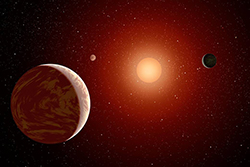 |
Planets Under a Red Sun10.24.2011This artist's concept illustrates a young, red dwarf star surrounded by three planets. View Image Feature |
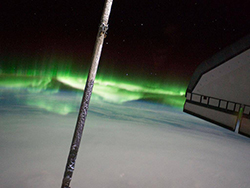 |
Aurora Australis From STS-13507.14.2011Space shuttle Atlantis, now docked to the ISS for the last resupply mission of NASA's 30-year shuttle program, witnessed the Aurora Australis. In addition to Southern Lights, the picture also frames Atlantis's port side wing and a segment of the boom sensor system attached to the shuttle's robotic arm. View Image Feature |
 |
Aurora Australis From South Pole07.14.2011The July 14, 2011 aurora Australis as seen from the Amundsen-Scott South Pole Station in Antarctica. The picture also shows the SPUD microwave telescope on the left. View Image Feature |
 |
Aurora Australis From ISS07.14.2011This panoramic shot of the aurora Australis also shows space shuttle Atlantis, the boom sensor system attached to the shuttle's robotic arm, and a portion of the International Space Station's (ISS) solar panels. View Image Feature |
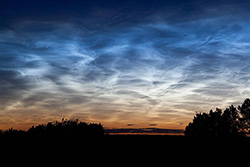 |
Canadian NLCs07.12.2011This Notilucent cloud image was taken on July 2, 2011 near Edmonton, Alberta Canada. The photographer said he “Noticed the clouds just before local midnight, continued past 2:00 am and were still bright enough to reflect in a local slough.” View Image Feature |
 |
NLCs - Scotland07.12.2011Adrian Maricic of Loch Leven Fife Scotland has witnessed almost a week of notilucent clouds this season. He took this image on July 2, 2011. View Image Feature |
 |
Sunrise Noctilucent Clouds07.12.2011Sunrise noctilucent clouds (NLC) over Szubin, Poland on July 10, 2011. July 2011 has been a banner month for these mysterious clouds. Normally confined to polar latitudes, NLCs have been sighted in recent nights as far south as France in Europe and Kansas and Colorado in the United States. View Image Feature |
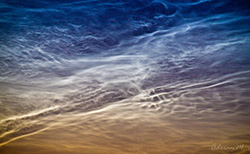 |
NLCs in Scotland07.11.2011Night-shining, or noctilucent clouds on July 3, 2011, in Lock Leven, Fife, Scotland. View Image Feature |
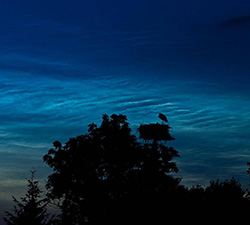 |
Return of Storks and NLCs06.26.2011This image was taken on June 26, 2011 in Szubin, Poland of a nesting stork against a backdrop of electric blue clouds. Yearly noctilucent clouds (NLC) arrival is also the time of birth of young storks. View Image Feature |
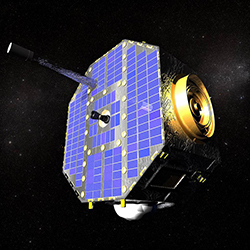 |
IBEX Spacecraft03.21.2011Artist rendition of IBEX spacecraft. View Image Feature |
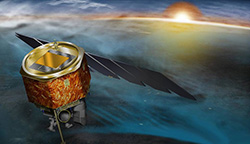 |
AIM Spacecraft03.21.2011Artist's rendition of the AIM spacecraft in orbit above Earth with the sun breaking over the globe's horizon. View Image Feature |
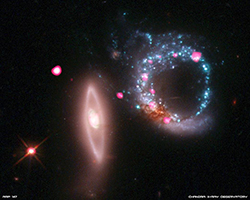 |
Giant Ring of Black Holes02.14.2011Just in time for Valentine's Day comes a new image of a ring - not of jewels - but of black holes. View Image Feature |
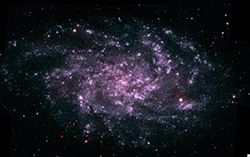 |
The Triangulum Galaxy01.12.2011The Triangulum Galaxy is located nearly 3 million light years from Earth. And, in a study that pushes the limits of observations currently possible from Earth, a team of NASA and European scientists recorded the “fingerprints” of mystery molecules in the Triangulum Galaxy, as well as the Andromeda Galaxy. View Image Feature |
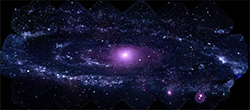 |
Ultraviolet10.27.2010This mosaic of M31 merges 330 individual images taken by the Ultraviolet/Optical Telescope aboard NASA's Swift spacecraft. It is the highest-resolution image of the galaxy ever recorded in the ultraviolet. View Image Feature |
 |
Comet Lulin07.22.2010NASA's Swift satellite views Comet Lulin as it made it closest approach to Earth in February 2009. Lulin, like all comets, is a clump of frozen gases mixed with dust. View Image Feature |
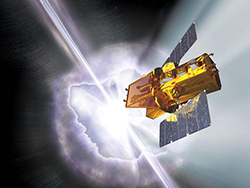 |
Artist's Concept of SWIFT05.26.2010An artist's rendering of the Swift spacecraft with a gamma-ray burst going off in the background. View Image Feature |
 |
The Possibility of a Brand New World02.26.2010Several of the dwarf galaxies in the Hickson Compact Group 31 are slowly merging. View Image Feature |
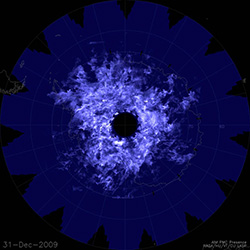 |
Noctilucent Cloud Cover Above the South Pole12.31.2009Looking down from above, AIM captured this composite image of the noctilucent cloud cover above the Southern Pole on December 31, 2009. The 2009 cloud season began a month before the 2010 season. VIew Image Feature |
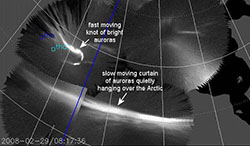 |
Auroras Poised to Collide12.16.2009A fast-moving knot of auroras is poised to collide with a slower moving curtain hanging over the Arctic. THEMIS all-sky imagers (ASIs) photographed the collision on Feb. 29, 2008. View Image Feature |
 |
AIM Polar Mesospheric Clouds12.15.2009This image of Polar Mesospheric Clouds (PMC) from the Aeronomy of Ice in the Mesosphere Cloud Imaging and Particle Size (AIM-CIPS) instrument on July 14, 2009 in the northern polar region. View Image Feature |
 |
Andromeda in Ultraviolet10.14.2009In a break from its usual task of searching for distant cosmic explosions, NASA's Swift satellite acquired the highest-resolution view of a neighboring spiral galaxy ever attained in the ultraviolet. View Image Feature |
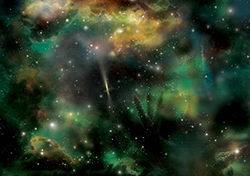 |
Shedding Light on Dark Gamma Ray Bursts06.16.2009Gamma-ray bursts are the universe's biggest explosions, capable of producing so much light that ground-based telescopes easily detect it billions of light-years away. View Image Feature |
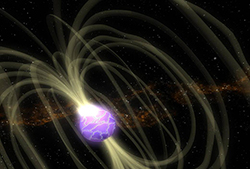 |
Flare02.10.2009Gamma-ray flares from SGR J1550-5418 may have arisen when the magnetar's surface suddenly cracked, releasing energy stored within its powerful magnetic field. A magnetar is a neutron star with a super-strong magnetic field. View Image Feature |
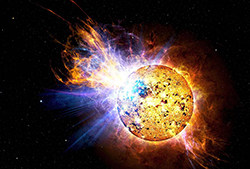 |
Pipsqueak Star Unleashes Monster Flare05.20.2008For many years scientists have known that our sun gives off powerful explosions, known as flares, that contain millions of times more energy than atomic bombs. View Image Feature |
 |
In a Burst of Light03.23.2008Gamma rays produce flashes that are brighter than a billion suns yet last only a few milliseconds and have been simply too fast to catch…until now. The artist's concept above depicts the sequence of events as a black hole devours a neutron star, producing gamma-ray bursts as it does so. View Image Feature |
Tracking Space Weather03.23.2008THEMIS' mission is to help improve the understanding of severe space weather effects on Earth. THEMIS (Time History of Events and Macroscale Interactions during Substorms) is designed to discover what causes intense displays of the aurora (northern and southern lights), called substorms. View Image Feature |
|
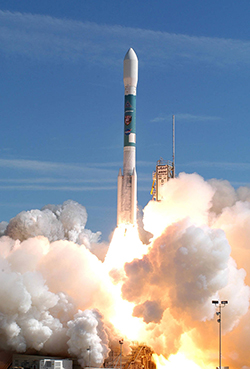 |
Swiftly Into Orbit03.23.2008A Boeing Delta II rocket, left, fires its engines on Saturday, Nov. 20, sending NASA's Swift satellite into orbit from the Cape Canaveral Air Force Station in Florida. The satellite will pinpoint the location of distant yet fleeting explosions (artist's concept at right) that appear to signal the births of black holes. View Image Feature |
 |
Taking AIM at Mysterious Clouds03.23.2008A NASA satellite has captured the first occurrence of mysterious shiny polar clouds that form 50 miles above Earth's surface. The AIM (Aeronomy of Ice in the Mesosphere) spacecraft returned some of the first data on these noctilucent or “night shining” clouds on June 11, 2007. View Image Feature |
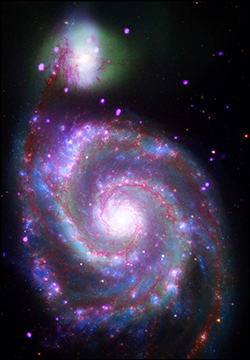 |
A Classic Beauty03.23.2008M51, whose name comes from being the 51st entry in Charles Messier's catalog, is considered to be a classic example of a spiral galaxy. View Image Feature |
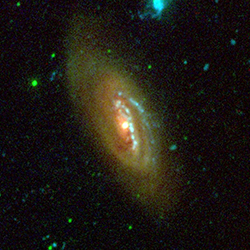 |
In the Constellation Virgo03.23.2008One of the largest and brightest spiral galaxies found in the Virgo cluster of galaxies, this image of galaxy NGC 4569 was taken by NASA's Galaxy Evolution Explorer. View Image Feature |
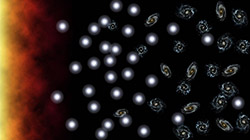 |
Baby Galaxies in the Adult Universe03.23.2008This artist's conception illustrates the decline in our universe's "birth-rate" over time. View Image Feature |
 |
Glitzy, Glamorous Galaxy03.23.2008This color composite image of nearby galaxy NGC 300 combines visible-light (red and yellow) with ultraviolet views (blue) from NASA's Galaxy Evolution Explorer (GALEX). View Image Feature |
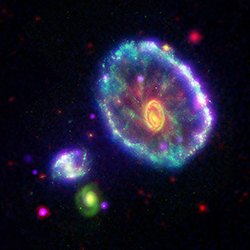 |
Stellar Ripple03.23.2008Approximately 100 million years ago, a smaller galaxy plunged through the heart of the Cartwheel galaxy, creating ripples of brief star formation. View Image Feature |
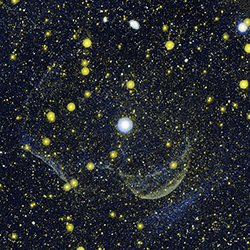 |
A Ghostly Presence03.23.2008This composite image shows Z Camelopardalis, or Z Cam, a double-star system. View Image Feature |
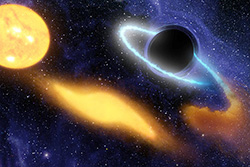 |
Black Hole Grabs Starry Snack03.23.2008This artist's concept shows a supermassive black hole at the center of a remote galaxy digesting the remnants of a star. View Image Feature |
 |
Orbiting a Red Dwarf Star03.23.2008This artist's concept of a gas giant planet orbiting a red dwarf K star shows a planet has not been directly imaged, but its presence was detected in 2003 microlensing observations of a field star in our galaxy. View Image Feature |
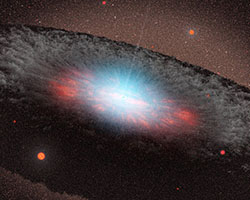 |
An Unwelcome Place for New Stars03.23.2008This artist's concept depicts a supermassive black hole at the center of a galaxy. View Image Feature |
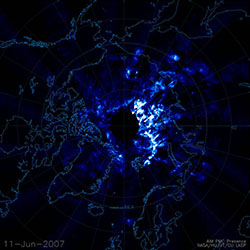 |
AIM First Data07.11.2007This image shows some of the first data returned from AIM, documenting noctilucent clouds located over the Arctic. This composite image was captured June 11, 2007. View Image Feature |
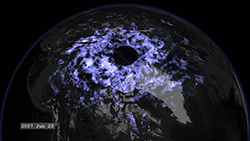 |
AIM Data from 200706.23.2007NASA's Aeronomy In the Mesosphere (AIM) mission captures images like this of shining noctilucent clouds, also known as polar mesospheric clouds (PMCs), which hover over Earth's poles in summertime. View Image Feature |
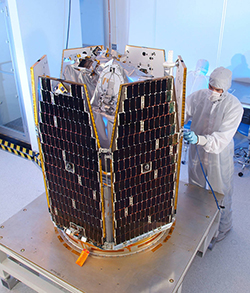 |
AIM Solar Arrays in Stowed Configuration03.11.2007The AIM spacecraft undergoes solar array deployment tests at Orbital's Dulles, Virginia satellite manufacturing facility. View Image Feature |
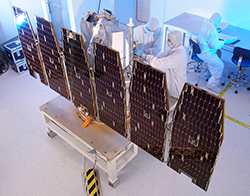 |
AIM Solar Array Deployment03.11.2007The AIM spacecraft undergoes solar array deployment tests at Orbital's Dulles, Virginia satellite manufacturing facility. View Image Feature |
 |
AIM Arrays Fully Deployed03.11.2007The AIM spacecraft undergoes solar array deployment tests and is shown here in full deployment. View Image Feature |
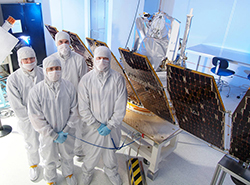 |
AIM Team03.11.2007The AIM team in bunny suits poses next to the satellite at Orbital's Dulles, Virginia satellite manufacturing facility. View Image Feature |
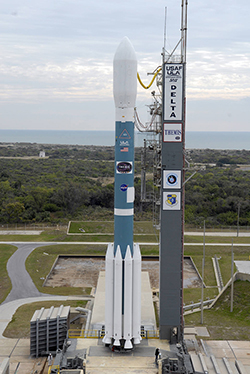 |
THEMIS on the Launch Pad02.09.2007The Delta II rocket carrying the five THEMIS spacecraft waits on the pad at Space Launch Complex 17, Cape Canaveral Air Force Station, Florida. View Image Feature |
 |
THEMIS-Aligned12.11.2006The THEMIS spacecraft will line up at midnight over the United States every four days. The distances range from about half the distance to the moon to about sixth of the distance to the moon. This position will help scientists pinpoint exactly when and where substorms occur. View Image Feature |
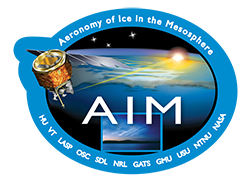 |
AIM Logo09.13.2006Logo for the NASA's Aeronomy of Ice in the Mesosphere (AIM) satellite mission. View Image Feature |
 |
Thermal Vacuum Test Preparation08.01.2006THEMIS Probes 3 and 4 being prepared for Thermal Vacuum chamber. Probe 3 in its box. View Image Feature |
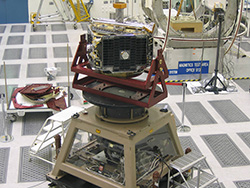 |
Spin Balance Test08.01.2006THEMIS Probe 5 at spin balance using the Miller table. View Image Feature |
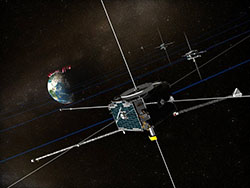 |
THEMIS Spacecraft07.26.2006Artist rendition of THEMIS spacecraft. View Image Feature |
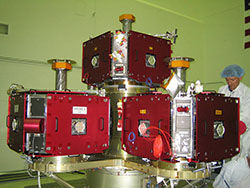 |
Five THEMIS Probes Mounted on the Probe Carrier07.13.2006All five THEMIS probes mounted on the Probe Carrier at the Jet Propulsion Laboratory, Pasedena, CA. View Image Feature |
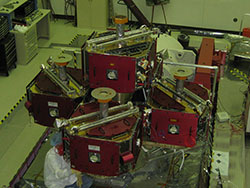 |
THEMIS at JPL07.13.2006Viewed from above, all five THEMIS probes mounted on the Probe Carrier at the Jet Propulsion Laboratory, Pasedena, CA. View Image Feature |
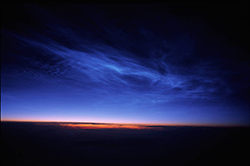 |
Noctilucent Clouds06.20.2006Noctilucent Clouds taken from 36,000 feet above the South of Nunivak Island, Alaska on June 20, 2006. View Image Feature |
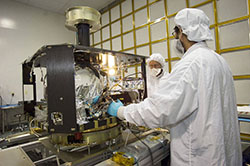 |
THEMIS in Cleanroom-305.20.2006THEMIS in the Swales Aerospace Cleanroom/Probe 3 Bus Avionics Unit Installation and Checkout. View Image Feature |
 |
THEMIS in Cleanroom-505.20.2006THEMIS in the Swales Aerospace Cleanroom/Probe 3 Bus Avionics Unit Inspection. View Image Feature |